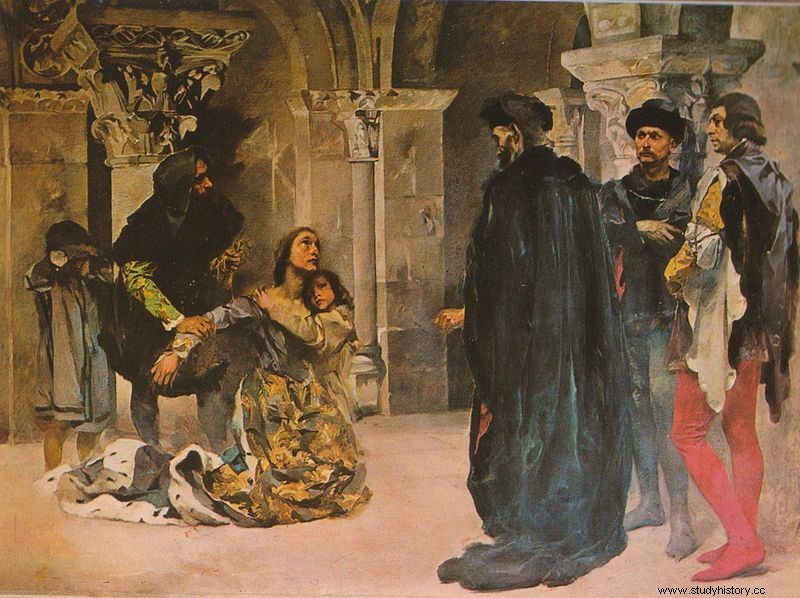There is a very fine line between love and madness. This was the case of Piotr the Righteous, who was brutally taken from his long-time lover. The fact that she was murdered did not prevent him from sharing his life - and power - with her. Apparently, it was not enough for him to "till death do us part" ...
In 1340, the retinue of Constance Manuel of Castile, the second wife of Prince Peter, heir to the Portuguese throne, arrived at the court of Alfonso IV. Among the courts of the ducal wife was Inês de Castro, a Galician noblewoman whose extraordinary beauty attracted the attention of the future ruler. Within a short time, the couple had a passionate romance. It has left its tragic mark on the pages of history, turning into a legend about great love, betrayal, murder and dark madness ...
Forbidden love
The relationship between Peter and Inês developed in the shadow of the Prince's unhappy marriage to Constance. And although the couple had three children, the intimate contacts between them resulted primarily from a sense of duty - to the lawful wife and the Portuguese throne.

Inês de Castro, a Galician noblewoman whose extraordinary beauty quickly attracted the attention of the future ruler.
This torment, however, did not last long. In 1345, Constance died in childbirth after the birth of Ferdinand, the long-awaited heir to the throne. Instead of mourning, Peter saw this event as an opportunity for personal happiness at the side of Inês de Castro.
He stubbornly rejected further marriage proposals with other noblewomen. There was only room for one woman in his heart (with whom he had four children in the meantime). The problem was that the relationship was perceived as dangerous for the country for political reasons.

Peter I the Cruel and the Corpse Queen Inês
The de Castro family was considered an influential Castilian family. Both the Portuguese nobility and Alfonso IV did not like the potential influence of the Inês brothers on the future ruler, and thus on the politics of the kingdom . It was this fear that sealed the fate of lovers. Things were about to get tragic soon.
Crime and Punishment
Knowing the mood in the court, Peter was aware that he would probably never receive official permission to marry Inês. The couple decided to seal their relationship secretly - it happened in 1354. When news of the event finally reached Alfonso IV, the king became furious. Blatant disobedience and rebellion - this is how the ruler of Portugal took away the secret marriage of the heir to the throne. He decided to put an end to forbidden love by ordering the murder of his unwanted daughter-in-law in January 1355.
There are legends about the execution of Inês de Castro to this day. Destiny was to meet her within the walls of Quinta das Lágrimas. There, in front of the children, the would-be queen was brutally stabbed to death amid cries of pleading for mercy to the unshakable sight of the dying Alfonso IV. At least, such a vision was perpetuated by the texts of culture. But the truth was just as ruthless.
Inês was executed on January 7, 1355 in the Convent of Santa Clara in Coimbra, where she was alone with her children while her husband was away.

Death of Ines de Castro
Peter, having learned about everything, fell into a rage and started a revolt against his father. Civil war ravaged the country for seven months, plunging Portugal into chaos, blood and fire of destruction. The end put her in the king's ill health. Like it or not, Peter had to make peace with Alfonso when he was on his deathbed.
The peace was temporary, however, because with the departure of Alfonso IV from this world, the new king resumed a vendetta against the three assassins of Inês. Bloody Revenge has earned him one of the nicknames by which he is known to this day - Cruel.
Peter I the Cruel and the Corpse Queen Inês
Two years after the murder of his beloved, Piotr managed to track down his wife's two murderers and take revenge on them in an extremely cruel way. First they were whipped, then to long, terrible tortures, finally ending in death by tearing their hearts out - one from the breast and the other from under the shoulder blade. This slow agony was to be seen by the king himself, who - according to legend - watched everything with his courtiers during the feast.
However, this tragic story did not end there. Her last act remains to this day one of the most terrifying stories of madness that can overwhelm a human.
In order to honor his wife's memory and award her the title of royal wife and queen of Portugal, Peter I ordered the exhumation of Inês de Castro's body. Then he brought his beloved's decaying body to Alcobaça, where it was adorned with coronation robes and insignia of power and placed on the throne . The entire royal court was to pay tribute to Queen Inês by kissing her in a ring set on a rotting hand.

Sculpture of Inês de Castro from her tombstone in Alcobaça
After all, the ruler was placed in a new tomb in a Cistercian monastery, and over time a second one was built in front of him - for Peter I. This symbolic arrangement of burial places is to guarantee that lovers will arise on the final judgment day, the first thing they see is each other.
Their graves are decorated with the inscription "Ate ou fim de Mundo" - "To the end of the world".
